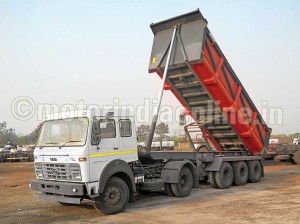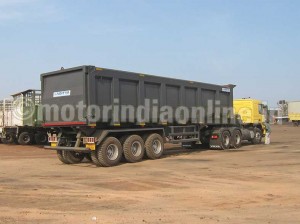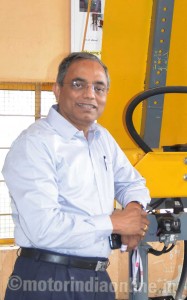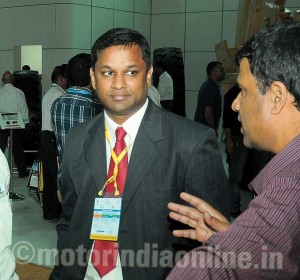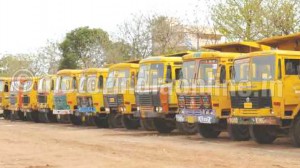“Working in challenging site conditions at peak performance levels to log higher productivity and profitability”
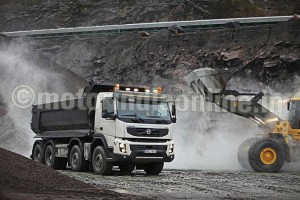 The oft-repeated quote “when the going gets tough, the tough gets going” of Joseph P. Kennedy should indeed aptly fit the Tippers and Tip Trailers, the workhorses of the CV segment deployed for bulk material transport in infrastructure, construction, mining, road laying, irrigation, projects, waste management, etc., operating round the clock in gruelling site conditions. These ubiquitous vehicles that can be seen as one crosses the periphery of the cities/towns, dotting the highways and construction sites, transport earth and aggregates, coal, ores, minerals, limestone, rocks, etc., to drive the all-round growth in diverse industrial and services sectors; and thus forming irrefutably important constituents in the cogwheel of the nation’s economy.
The oft-repeated quote “when the going gets tough, the tough gets going” of Joseph P. Kennedy should indeed aptly fit the Tippers and Tip Trailers, the workhorses of the CV segment deployed for bulk material transport in infrastructure, construction, mining, road laying, irrigation, projects, waste management, etc., operating round the clock in gruelling site conditions. These ubiquitous vehicles that can be seen as one crosses the periphery of the cities/towns, dotting the highways and construction sites, transport earth and aggregates, coal, ores, minerals, limestone, rocks, etc., to drive the all-round growth in diverse industrial and services sectors; and thus forming irrefutably important constituents in the cogwheel of the nation’s economy.
Bulk material handling be it excavation, transport and delivery/discharge has been considered to be the toughest operational segment in the overall materials handling field. The same despite being considered difficult, messy, polluting and getting classified as ‘dirty cargo handling’ in ports and other locations, occupies an important slot in the business domain as it contributes significantly to the top and bottom lines of the tipper and tip trailer fleet operators. Yes, the prosperity of the fleet operators transporting the loose bulk material and vibrancy in the sector translates into impressive sales nos. for the OEMs. Hence it is not surprising to note that CV manufacturers have been going overboard in paying attention to this segment, actively collaborating with the end users, fleet operators and introducing on a regular basis various new models with improved features; and supporting the sale thro’ excellent and innovative service to lower the TCO for a competitive and profitable business to the contractors.
Evolution and trends
It was not long ago we had witnessed the trucks with side boards carrying sand and blue metal for construction activities plying in the cities and towns; and labourers armed with hand shovels emptying the payload at the construction sites. Well, today the manual unloading route has become history and the same replaced with tippers. Similar has been the case of cement transport, erstwhile transported in bags for concrete work getting replaced by bulkers and tip trailers (default for tipping semi-trailers in the context of local market) – same getting increasingly deployed to enhance the handling capacities and contribute to the overall efficacies To get the updates on the developments and future trends, we met a cross-section of the domain players and specialists – read on for their insights in the following sections.
Mr. Girish Garud, Managing Director, Interpump Hydraulics, says: “In the initial stages when tippers got introduced in India, they were mainly used in the construction sector, later added by the mining applications. Now tippers have undergone radical changes in design and size making it most suitable to almost all applications, including garbage handling, various port applications, and general bulk material handling in various industries. In future this industry will shift to using lighter and stronger materials in manufacturing, in addition to improved performances of the critical components in terms of reliability of the overall system”.
 Mining segment in which tippers were used to carry overburden in the past has in the recent times witnessed powerful and rugged tippers being deployed for intermediate and deep mining operations – carrying overburden, iron ore/coal from great depths challenging the off-road dumpers in their lower range. Mr. Rama Rao A.S., Sr VP, Sales, Marketing and Aftermarket, Volvo Trucks India, VECV indicates: “In mining application, horse power and torque are key vehicle parameters. As you dig deep, you need more HP & Torque to pull up, to get higher productivity while keeping the fleet sizes in control. With increase in demand for coal, our mines too have started expanding. Now days you would typically see mines that go up to 120 mtrs. depth, while the dump heights can go up to 60 mtrs. Similarly leads have also gone up to 5-6 Kms from earlier average of 2-3 Kms. Based on the strata/soil conditions we offer various body variants such as cladded, rock, standard & exhaust heated body options”.
Mining segment in which tippers were used to carry overburden in the past has in the recent times witnessed powerful and rugged tippers being deployed for intermediate and deep mining operations – carrying overburden, iron ore/coal from great depths challenging the off-road dumpers in their lower range. Mr. Rama Rao A.S., Sr VP, Sales, Marketing and Aftermarket, Volvo Trucks India, VECV indicates: “In mining application, horse power and torque are key vehicle parameters. As you dig deep, you need more HP & Torque to pull up, to get higher productivity while keeping the fleet sizes in control. With increase in demand for coal, our mines too have started expanding. Now days you would typically see mines that go up to 120 mtrs. depth, while the dump heights can go up to 60 mtrs. Similarly leads have also gone up to 5-6 Kms from earlier average of 2-3 Kms. Based on the strata/soil conditions we offer various body variants such as cladded, rock, standard & exhaust heated body options”.
Construction and Mining Tippers
The application segment assumes importance as it caters directly to the infra projects, mining, core sector and miscellaneous construction activities – essentially supporting the main production machines like excavator, front-end loader, dozer, Backhoe, etc.; with the applications being so diverse, the sales nos. in the class is also the highest garnering over 80% of all the tippers sold in the marketplace. The popular body sizes range from 6 cu.m to 36 cu.m or more depending upon vehicle load ratings and payload material densities. Tippers in the ICV/LCV range are essentially used inside the cities/town to carry construction aggregates, debris & recyclable materials and their demand is sluggish due to the increasing use of dedicated vehicles like transit mixers. There are then the special class tippers like Side tipper, 3 way tipper and Roll-off tipper (referred also as Hooklift or Hook loader) used in select segments of construction, but the sales nos. are on the lower side. But this niche class is expected to register better growth rates in the future with increased awareness of their flexible/versatile designs for both general and special applications.
In the applications like ports, power plants, hydel and road projects the operational demands are high on tippers and fleet operators always under pressure to keep the costs under control. Mr. Vinod Sahay, Head Sales & Marketing, Medium & Heavy Commercial Vehicle Trucks, Tata Motors, briefs: “In our constant endeavour to minimise Total Cost of Operations (TCO), along with providing customers with unmatched service quality, we at Tata Motors believe that a superior product alone is not enough for successful completion of projects, hence we support our customers through innovative customised offerings. We provide various offerings including 24×7 onsite Support Service through Mobile Service Vans, along with Extensive Driver & mechanic training. We also ensure quick services from our widest service network of our dealers and Tata Authorised Service Stations (TASS) across India”.
Mining segment is probably the toughest in the tipper domain and by logical deduction should also turnout to be the most difficult application in the CV sphere. Consider the operating conditions in diverse mining sites like ambient temperatures ranging from low single digit to as high as 50 deg celsius, uneven slushy terrains with steep climbs, stiff time deadlines, 20 plus working hours in a day, poor visibility conditions et al. It can not get any worse for the man-machine combo and the testing application stretches the endurance limit of the vehicles to the extremities; and driver skill and productivity become crucial in the applications. Mr. Rama Rao points out “Driver productivity is the key element in transport operations. Therefore, even before we rolled out our first truck in India, we had set up the first of its kind driver training centre in Bangalore. Our DTC offers both onsite training for Volvo tipper customers and training in Bangalore for Volvo tractors and buses. Over the past 16 years we have even customized our training programme to meet customer’s specific needs. Our focus is to help our customers to continually develop the driver in the areas of sense of responsibility, motivation, fuel efficient driving, traffic safety, social aspects and preventive maintenance”.
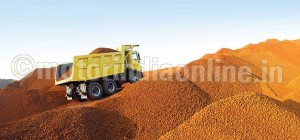 Mr. Sivakumar. V, Director – Sales, Scania CV India, says: “Scania is present only in the premium segment off road mining tipper business and has a unique 2 pedal Opticruise system that gives many advantages to the truck driver; salient features of the same include, Adaptive starting gear selection, Inclination sensor for detecting gradients, Manoeuvring mode for precision handling at low vehicle speeds, Hill hold, Rocking feature for taking-off in tricky situations, Faster and smoother gear changes & Electric clutch control”. Such features should ensure that even a driver with lesser driving skills can turn in an expert driver’s performance thus ensuring fuel efficiency and operational productivity.
Mr. Sivakumar. V, Director – Sales, Scania CV India, says: “Scania is present only in the premium segment off road mining tipper business and has a unique 2 pedal Opticruise system that gives many advantages to the truck driver; salient features of the same include, Adaptive starting gear selection, Inclination sensor for detecting gradients, Manoeuvring mode for precision handling at low vehicle speeds, Hill hold, Rocking feature for taking-off in tricky situations, Faster and smoother gear changes & Electric clutch control”. Such features should ensure that even a driver with lesser driving skills can turn in an expert driver’s performance thus ensuring fuel efficiency and operational productivity.
Growth drivers and challenges
What are the growth drivers for the tipper segment and the demands likely in the next 5 to 10 years? Some of the factors being put forward by domain observers include FDI inflows for various infrastructure related programs/business ventures, implementation of big-ticket projects like the ultra mega power plants, steel plants, airports, ports, et al. Mr. Sudhir Prabhu, M.D., Hypratek Fluid Power, opines: “The major movement in demand for tippers shall be infrastructure driven and would depend mostly on Government spending and policies. With Government planning to build 8500 Km of National highways and budgeting Rs. 37,800 crores in current year for Road Transport Highways, we expect a high demand for tippers across various models; River joining project shall be the mother of all projects; Irrigation projects shall be the highest demand raiser of tippers & tipper trailers. We believe the tipper segment will grow annually @ 15% over the next 10 years which should be good news for the entire industry”.
Despite the glorious past, enormous latent potential, high growth rates forecast and the understandable business hype, the segment has gone thro’ one of the worst patches in the recent past – economy gloom bringing to a halt the major/big projects and as well as the real estate/construction related activities; compounded further by closure of several iron ore and coal mines due to judicial regulations and other extraneous factors. Mr. Vinod Sahay summarises: “The biggest concern for the CV industry today, is the challenging macro-economic environment in the country. It is difficult to predict exact macroeconomics, as this is not really an automotive issue. The current economic downturn includes concerns around potential food inflation, the fluctuating value of the Rupee, including other key elements. After nearly two years of decline, we have seen some plateauing of sales in the M&HCV segment, on what is a very low base. Other CV segments are yet to show signs of recovery. The decision to extend the reduced excise by six months is a good thing, with key policy interventions being announced to revive the economy. Only with improvement in macro-economic trends – especially growth in infrastructural development and overall investment sentiment – will we see a real turnaround in the CV industry”.
Well, to recall Robert H. Schuller’s popular book title “Tough times never last but tough people do” the tough tipper workhorses temporarily slipped out of limelight but have weathered thro’ the downturn storm to be back in the reckoning. With the changed political scenario and the general uplift in the business mood and sentiments, the tipper segment has just started looking up and the popular opinion of the domain critics is that it will return back to those vibrant days sooner than later. The CV manufacturers sensing the harbinger of an upswing and with the expectation ‘best is yet to come’ are ready with their product offerings for the demanding market needs. It’s definitely light at the end of a long tunnel, the same a good omen for the customers, fleet operators, OEMs and diverse suppliers who anticipate the business stretch ahead to be profitable for all concerned; and thro’ their active participation in the economic activities, all too willing to take the country to international standards in every facet of the bulk material transport operations.

